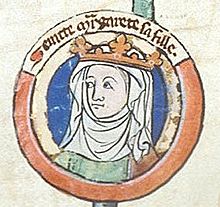Our website is made possible by displaying online advertisements to our visitors.
Please consider supporting us by disabling your ad blocker.
Saint Margaret of Scotland
| Saint Margaret | |
|---|---|
 St Margaret from a medieval family tree, 13th century | |
| Queen consort of Alba (Scotland) | |
| Tenure | 1070 – 13 November 1093 |
| Born | c. 1045 Kingdom of Hungary |
| Died | 16 November 1093 (aged 47–48) Edinburgh Castle, Kingdom of Scotland |
| Burial | |
| Spouse | |
| Issue more... | |
| House | Wessex |
| Father | Edward the Exile |
| Mother | Agatha |
| Religion | Catholicism |
Saint Margaret of Scotland (Scottish Gaelic: Naomh Maighréad; Scots: Saunt Marget, c. 1045 – 16 November 1093), also known as Margaret of Wessex, was Queen of Alba from 1070 to 1093 as the wife of King Malcolm III. Margaret was sometimes called "The Pearl of Scotland".[1] She was a member of the House of Wessex and was born in the Kingdom of Hungary to the expatriate English prince Edward the Exile. She and her family returned to England in 1057. Following the death of Harold Godwinson at the Battle of Hastings in 1066, her brother Edgar Ætheling was elected as King of England but never crowned. After the family fled north, Margaret married Malcolm III of Scotland by the end of 1070.
Margaret was a pious Christian, and among many charitable works she established a ferry across the Firth of Forth in Scotland for pilgrims travelling to St Andrews in Fife, which gave the towns of South Queensferry and North Queensferry their names. Margaret was the mother of three kings of Scotland, or four, if Edmund of Scotland (who ruled with his uncle, Donald III) is counted, and of Matilda of Scotland, queen consort of England. According to the Vita S. Margaritae (Scotorum) Reginae (Life of St Margaret, Queen (of the Scots)), attributed to Turgot of Durham, Margaret died at Edinburgh Castle in 1093, days after receiving the news of her husband and son's deaths in battle.
In 1250, Pope Innocent IV canonised Margaret, and her remains were reinterred in a shrine in Dunfermline Abbey in Fife. Her relics were dispersed after the Scottish Reformation and subsequently lost. Mary, Queen of Scots, at one time owned her head, which was subsequently preserved by Jesuits in the Scots College, Douai, France, from where it was lost during the French Revolution.
Previous Page Next Page
سانت مارغريت من إسكتلندا Arabic سانت مارجريت من اسكتلندا ARZ Маргарыта Шатландская BE Маргарет Шотландска Bulgarian Marc'harid Bro-Skos (santez) BR Margarida d'Anglaterra Catalan Markéta Skotská (svatá) Czech Margrethe af Skotland (helgen) Danish Margareta von Schottland German Αγία Μαργαρίτα της Σκωτίας Greek


